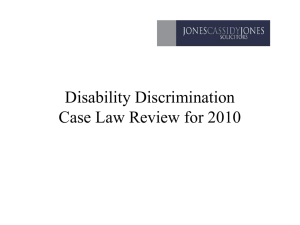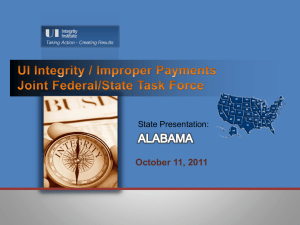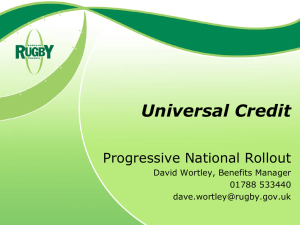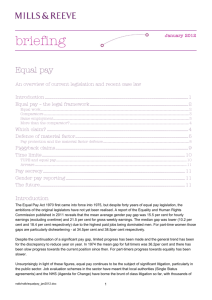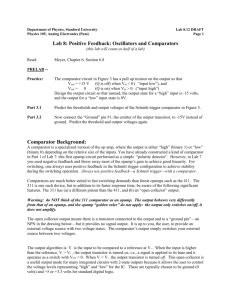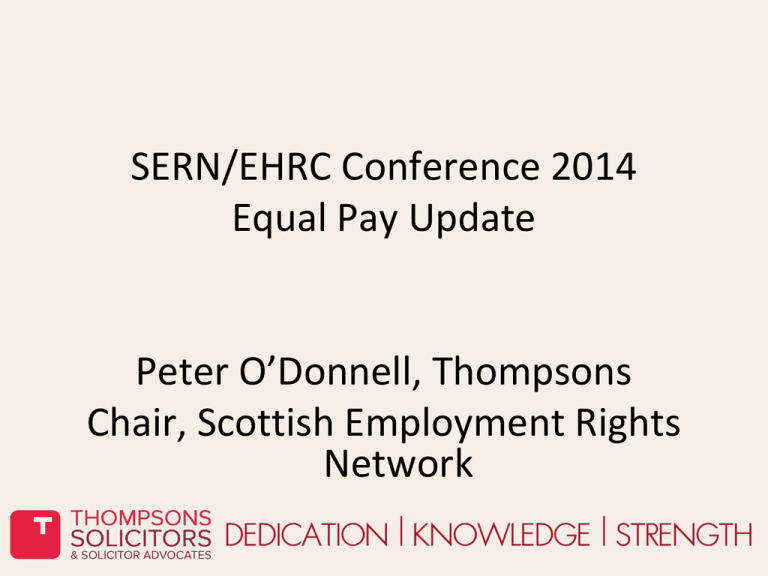
SERN/EHRC Conference 2014
Equal Pay Update
Peter O’Donnell, Thompsons
Chair, Scottish Employment Rights
Network
Forum for claims
• Abdullah v Birmingham City Council [2013] IRLR
38
– 6 month time limit for pursuing claims in ET
– Longer period in civil courts
– Could claim be brought in courts where timebarred in
ET?
• Question centred on whether claim could be more
“conveniently” be disposed of by ET?
– If so then court could strike out claim
• Supreme Court held that claim cannot be more
conveniently disposed of by ET where it is timebarred
Limits on Abdullah
• Abdullah was concerned with jurisdiction
– Does not mean that these claims were guaranteed to
succeed
• Does not mean that claimant can bring any claim
that they wish for some earlier period
– 5 year backdating period for EP claims still apply
• Reason why claim was time-barred is not relevant to
issue of whether claim can be brought
– Could be relevant to costs
Scope of Comparison
• Require to have actual comparator who meets
certain criteria
–
–
–
–
Opposite sex
Paid more
Do equal work
Work in the same employment
• 2 cases have recently dealt with issues related to
same employment
Associated employers
• Can use comparator who works for associated
employer
• Particular important where claimant has TUPE
transferred
– 6 month time limit for pre-transfer period
– Can pursue claim for post-transfer period
• Difference in pay will be dynamic if associated employers
• Difference in pay frozen as at point of transfer if not
– Gutridge v Sodexho
• Glasgow City Council v UNISON Claimants [2014]
IRLR 532
Definition of Associated Employers
• Employers are associated if:– One is a company of which the other (directly or
indirectly) has control
– Both are companies of which a third person (directly or
indirectly) has control
• Similar definition used in the Employment Rights
Act in context of continuous service
Facts of Glasgow case
• GCC created a number
organisations (ALEOs)
of
arms-length
external
– Company limited by guarantee
– LLP
• Staff transferred from council to different ALEOs
– Large number of claimants transferred (eg care, cleaning and
catering staff transferred to Cordia)
– Comparators remained with council
• Were the ALEOs “associated employers” of the council?
– ET found that the council had the necessary degree of control of
the ALEOS and cases centred on whether “company”
Decisions of the courts
• ET
– Found that company limited by guarantee was associated employer
• Never been appealed
– Found that LLP was not a “company” (ie not an entity defined as a
company under the Companies Act 1998)
• EAT
– Decided that word “company” could be read to include LLP
• Purposive approach to anti-avoidance provision
• Inner House
– Agreed with EAT – ET used too restrictive approach
– Ordinary meaning of the word “company”
• “a company is an association of persons for an economic purpose, usually
entered into with legal advice and some degree of formality”
– Re a Company (No 00709 of 1992) O’Neill v Phillips [1999} 1 WLR 1092 HL
Same Employment
• Can use comparator
employment
who
works
in
same
– Works for same employer at same establishment
– Works for same employer at difference establishment and
common terms apply at the establishments (either
generally or as between claimant and comparator)
• Became an issue in local authority litigation
– Claimants based in schools on APT&C terms using
peripatetic workers on Manual Worker terms
– North v Dumfries & Galloway Council [2013] IRLR 737
– City of Edinburgh Council v Wilkinson [2012] IRLR 202
Principles derived from the decisions
• “Establishment” does not mean “employer”
– Inner House (Wilkinson) overturning EAT
– A particular employer could contain a number of establishments
• Eg different services in a local authority
• Whether common terms exist may require ET to speculate
as to what terms comparator may enjoy if worked at
claimant’s establishment
– Not necessary to show real possibility or even that it was feasible
that comparator would have been employed at that place
• Inner House & Supreme Court (North) and EAT & Inner House (Wilkinson)
disapproving EAT (North)
Job Evaluation
• UNISON Claimants & ors v GCC (No.2)
• Used JES that evaluated role profiles rather than jobs
– Created job families containing a number of role profiles
– JES evaluated demands of role profiles
– Individual jobs matched to role profiles to determine base pay
• JES splits evaluation of demands
– 8 factors used to assess role profiles to determine base pay
– 5 factors used to assess individual jobs for additional payment
• Does this meet test for analytical job evaluation scheme?
– Yes, says ET
– Subject to appeal – watch this space
Equal Pay Audits
• Power granted to make regulations under Enterprise & Regulatory
Reform Act 2013
• Draft regulations published in June 2014
– Apply to claims lodged after 1 October 2014
– ET must order an equal pay audit where they find an equal pay breach
• Certain circumstances where audit must not be ordered (eg audit already done)
• Exemption for new and micro-businesses
– Requirements of content of audit
• Descriptions of persons for whom gender pay information must be included and
period of time to which audit relates
• Time by which employer must respond
– ET will determine if order has been complied with
• May hold hearing to consider
• Remedy for failure to comply
– Further order to comply
– Financial penalty payable to Secretary of State
– Audit must be published
What next?
• Holiday Pay
– Potentially tens of thousands of claims across public & private
sector
– Issue relates to failure to include additional payments when
employees take holidays
• Holiday pay should be based on “normal remuneration (Williams & ors v BA
and Lock v British Gas Trading Ltd)
– Include payments intrinsically linked to performance of jobs (eg commission,
– Number of issues still to be determined
• How far does “normal remuneration” go?
– Overtime?
• What is reference period for calculating “normal remuneration”?
– 12 weeks, 12 months?
• Does this apply to 4 weeks or 5.6 weeks?
• How far back can you go?

